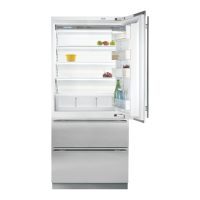FRAMED CABINETRY
Traditional Frame –
3
/8" (10) offset
(top view).
Traditional Frame – standard overlay
(top view).
Traditional Frame – full overlay (top view).
SUB-ZERO
UNIT
P
ANEL
C
ABINET
D
OOR
CABINET
FRAME
TO WALL
24
(
610)
T
1
/8" (3)
REVEAL
1
36
(
914)
3
PANEL
C
ABINET
DOOR
CABINET
F
RAME
SUB-ZERO
U
NIT
S
T
O WALL
24
(
610)
T
1
/8" (3)
R
EVEAL
1
36
(914)
3
PANEL
CABINET
DOOR
CABINET
FRAME
SUB-ZERO
UNIT
TO WALL
24
(610)
1
1
/8" (3)
REVEAL
3
36
(914)
FRAMED CABINETRY APPLICATIONS
Framed cabinetry applications present you with different
questions to address. The illustrations on this page show
common applications of framed cabinetry. These are not
meant to be the only alternatives, but are suggestions
from designers around the country. Also refer to the full-
scale illustrations at the end of this section for specifics
on door openings.
IMPORTANT NOTE: The depth of each Integrated unit is
24" (610) from the front of the unit to its back. You
must
allow for the thickness of the panel you are applying when
planning for the finished rough opening depth if you want
the front panel to be flush with surrounding cabinetry. You
may have to move the unit back into drywall or bring the
cabinets forward to achieve a flush fit. Refer to the
illustrations.
Illustrations on the following pages give dimensions for an
Integrated 36" (914) wide tall unit installed within a framed
cabinetry beaded inset application. Review the illustrations,
giving particular attention to the overall panel specifica-
tions. Also refer to the full-scale illustrations at the end of
this section for specifics on door openings.
Planning Information
Integrated Model 736TC(I)
Dimensions in parentheses are in
millimeters unless otherwise specified.
7

